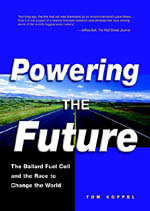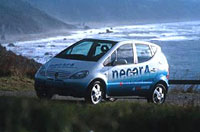“Our long-term goal is very simple,” said California Gov. Gray Davis (D) outside the state capitol in Sacramento in April 1999. “Zero emissions in the air. Zero. Nada. Nothing. Zip.” A crowd had gathered to hear Davis announce a major new state initiative, and to see the latest non-polluting automobiles to be unveiled by DaimlerChrysler and Ford. Running on electricity, the peppy performance of these cars dazzled the spectators. The two auto giants promised to have them in commercial production around 2003 or 2004. A new era of environmentally friendly transportation had begun.

Read more in Koppel’s book:
Powering the Future
John Wiley & Sons, Inc, 276
pages, 1999
At the heart of these vehicles is the Ballard fuel cell, the drastically improved version of an exotic and prohibitively expensive technology that was originally developed by General Electric for the U.S. space program and then shelved. A fuel cell is like a battery, but better. It requires no charging. It simply reverses the familiar high school science demonstration in which electricity is put through water to produce hydrogen and oxygen. In a Ballard fuel cell, a polymer plastic membrane coated with platinum is sandwiched between two flat electrodes. Hydrogen flows in on one side, oxygen from the air on the other. They combine to form water so pure you can drink it and generate electricity without combustion or nasty emissions.
The story of the Ballard fuel cell begins in 1975 in Arizona cactus country with Geoffrey Ballard, a tenacious and idealistic Canadian geophysicist who had directed lab research for the U.S. Army and headed an energy conservation program for the U.S. Department of Energy. Ballard poked his way through a derelict motel a short walk from the Mexican border and held his nose. He needed a cheap laboratory in which to pursue his dream of finding an alternative to the internal combustion engine. He bought the motel for $2,000 and burned the filthy matresses, but the building still stank, so he persuaded the local fire department to come for a training exercise. Watching their hoses blast the place clean, Ballard planned the layout of his lab, and how he would go about reducing the world’s consumption of fossil fuels.
Staying Power
For the first few years, Ballard and a few partners and cronies soldiered away on shoestring budgets, stumbling upon exotic chemicals and nearly blowing themselves up in the process. The company went bankrupt and then revived for a fresh start.

Life’s a beach with fuel-cell powered
cars.
Photo: DaimlerChrysler.
In 1983, after relocating to North Vancouver in British Columbia, the company got a small contract to develop a quiet power source with low infrared emissions for the Canadian military. Funding could only support a three-person technical team, working in an industrial bay next door to an auto body shop. They took the abandoned GE fuel cell — the patents were running out — and searched for ways to improve its power and build it out of much cheaper materials.
It was a case of small in fact being beautiful. There was no corporate bureaucracy to slow them down. If something didn’t work, they sent out for pizza and beer, stayed up until midnight, and tried an alternative approach.
One time, not expecting much, they replaced a membrane made by DuPont with one from Dow Chemical and left the cell running. To their amazement, it generated four times the previous power. As they watched, a finger-thick electric cable got so hot that the copper strands began to melt and fuse. They hooted and jumped around, sensing a great breakthrough.
They unveiled their results in 1986 in New Mexico at Los Alamos National Laboratory, where a team was assessing the potential of fuel cells for transportation. The key person there told them, “I don’t think you appreciate what it is you people have done, but you’ve made the electric vehicle possible.” Until then, the U.S. government had been putting most of its research money into another type of fuel cell. Days later, when Ballard’s achievement was announced at a fuel-cell conference in Arizona, a U.S. Department of Energy scientist gasped, “My God, we’ve been backing the wrong technology.”
Getting the Ballard Rolling
The dramatic jump in power brought Ballard its first few million dollars in private venture capital. Progress continued rapidly. When an additional $10 million in development money was required, though, the investors insisted that Geoffrey Ballard and his partners, chemist Keith Prater and engineer Paul Howard, give up control of their company and move a bit to the sidelines. It was a difficult pill to swallow, but they recognized that they lacked the skills to negotiate joint ventures with larger companies that would bring their fuel cell to major world markets.

Get on the fuel-cell bus, Gus.
Image: DaimlerChrysler.
In came a savvy engineer with marketing experience named Firoz Rasul, who has been CEO of Ballard Power for the last decade. (Geoffrey Ballard remained as board chair until the end of 1997.) Rasul built the company from 37 employees in 1989 to over 650 today and took it public in 1993. He forged a key alliance with Germany’s Daimler-Benz corporation, which put Ballard cells into a series of impressive prototype vehicles. Meanwhile, Ballard built its own series of fuel-cell transit buses, which have been carrying paying passengers in Chicago and Vancouver for two years.
When Daimler and Ford made a billion-dollar investment in Ballard in 1997, acquiring 35 percent of Ballard stock, the world really took notice. Ballard Power’s share price soared 1,100 percent in three years, and it has doubled again in just the last few months. Today, Ballard Power is widely acknowledged to be the world leader in fuel-cell technology.
The company’s current fuel-cell units are the size of a small suitcase and have ample power to run a four- or five-passenger car. The DaimlerChrysler/Ford/Ballard alliance has promised that it will have fuel-cell cars on the road by 2004, in time to meet a California mandate that 10 percent of new cars sold in the state be zero-emission. Not wanting to be left behind, General Motors and Toyota have announced that they, too, will have fuel-cell cars ready for mass production around 2004.
There are technological and practical hurdles to be overcome, one being the establishment of the necessary fuel infrastructure for the new vehicles. Ferdinand Panik, head of DaimlerChrysler’s fuel-cell subsidiary, concedes that it will be around 2010 before fuel-cell vehicles match traditional cars in performance and cost. Under an optimistic scenario, he adds, they will account for up to 25 percent of the global market by 2020. Still, there seems little doubt that the transition to this new green transportation technology is imminent.
Soon They’ll Be Celling Like Hotcakes
Though most of the buzz around fuel cells has centered on their potential to revolutionize transportation, most consumers are likely to benefit first from stationary fuel cells that provide clean electricity. This huge potential market is being targeted not only by Ballard but by such competitors as Plug Power, International Fuel Cells, H-Power, and Avista (now backed by Bill Gates) in the U.S. and by Siemens in Germany.
Giant generating plants powered by fuel cells h
ave already been built, including one in Japan with output of 11 megawatts. But most of the stationary market is focused on much smaller units. Called “stacks,” they add together the power of scores or hundreds of individual fuel cells.
Medium-sized fuel-cell stacks, in the range of 100 to 250 kilowatts and running on natural gas, are already on sale. These are ideal for providing power to remote commercial facilities or to clusters of vacation homes that are far off the grid. Parts of the developing world that do not yet have a far-reaching power grid are a giant future market.
But even with grid access, special needs can make fuel cells attractive. A 200-kilowatt unit was installed at a police station in New York’s Central Park to avoid having to dig up parkland to install underground cables. Fuel-cell systems can also supply high-quality uninterrupted power to computer centers and hospitals. One is being installed at a credit-card processing facility in Nebraska where high reliability is a must.

Coming soon to a mall near you.
Photo: NREL/PIX.
Several companies are developing much smaller units (three to seven kilowatts) designed to supply electricity for single houses. These may prove especially practical where per kilowatt electricity costs are high.
Another notch down in size, Ballard has teamed up with Coleman Powermate in the U.S. to build handy one-kilowatt generators. Imagine having portable, silent backup power to fall back on when wind and falling trees cause an outage. Or to run an electric lawnmower, weedeater, or chainsaw without long extension cords. Or to take along for lights when camping. Ballard recently announced that these small units will be for sale by the end of 2001.
Close behind in development are ultra-portable micro fuel cells in the 20- to 100-watt range, which could replace batteries in cell phones, computers, and camcorders.
“Not long ago, the fuel cell was dismissed as an environmentalist’s pipe dream that wouldn’t be road-ready anytime soon,” wrote a Wall Street Journal reporter a little over a year ago. “Now it is the subject of a heavily financed research-and-development race among some of the world’s biggest automakers.” And fuel cells are likely to hit shopping malls before they even get to car dealerships.
This article is adapted from Powering the Future: The Ballard Fuel Cell and the Race to Change the World, © 1999 Tom Koppel, published by arrangement with John Wiley & Sons, Inc.



